Sharpen Your Financial Analysis Knowledge: Formula, Computation, and Significance of Sharpe Ratio
The Sharpe Ratio is a popular metric used to measure the attractiveness of an investment, particularly in the world of mutual funds. This ratio provides a risk-adjusted return, making it an essential tool for investors seeking to compare funds within the same category.
Calculating the Sharpe Ratio
The Sharpe Ratio formula is simple yet powerful:
[ \text{Sharpe Ratio} = \frac{\text{Fund Return} - \text{Risk-free Return}}{\text{Standard Deviation of Fund Returns}} ]
The fund return represents the historical returns of the fund, typically averaged annually. The risk-free return is usually set as the yield on 10-year government securities, and the standard deviation (SD) reflects the fund's total risk (both systematic and unsystematic) over a chosen period, often 3 years.
Comparing Mutual Fund Categories
The Sharpe Ratio is most effective when comparing funds within the same category, such as mid-cap equity, large-cap equity, or debt funds. For example, debt funds generally have lower volatility and lower Sharpe Ratios than equity funds due to their lower risk. Among equity funds, categories like large-cap, mid-cap, small-cap, value, or multi-cap have different risk-return profiles, so Sharpe Ratios are best compared within these sub-categories.
Factors Influencing the Sharpe Ratio
- Fund return (numerator): Higher returns increase the ratio.
- Risk-free rate: Changes in interest rates affect this baseline, thus influencing the ratio.
- Standard deviation of returns (denominator): Funds with higher volatility but not proportionally higher returns will have a lower Sharpe Ratio.
- Time period for returns and SD: The choice of period can affect the Sharpe Ratio.
- Distribution assumptions: The Sharpe Ratio assumes normally distributed returns, but real-world returns may be skewed or have fat tails.
Practical Use and Limitations
The Sharpe Ratio helps investors objectively compare mutual funds on a risk-adjusted basis. However, it has limitations, such as assumptions on return distribution, sensitivity to measurement period, and ignoring factors like liquidity or credit risk.
In summary, the Sharpe Ratio is a valuable yet nuanced tool for mutual fund evaluation. It should be used alongside other metrics and qualitative analysis for well-rounded investment decisions.
Notable Examples
- The PGIM India Midcap Opportunities Fund has the highest Sharpe ratio among Mid Cap Funds.
- Fund C delivers 10 percentage points higher returns than Fund A, but due to a higher standard deviation, the Sharpe ratio is the same for both funds.
- The Quant Small Cap Fund has the highest Sharpe ratio among Small Cap Funds.
- A Sharpe ratio of more than 1 is generally considered favorable, while a ratio below 1 is considered unfavorable.
- Fund A has a Sharpe ratio of 1.67.
Remember, the Sharpe Ratio is a relative measure, and it should be compared with other funds within the same category. When comparing funds with the same return, the fund with a lower standard deviation will have a higher Sharpe ratio. The Sharpe ratio gives the return delivered by a fund per unit of risk taken, but it does not take into account all positive deviations from average or mean when calculating standard deviation.
Lastly, the Sharpe ratio should not be the only criteria for choosing a fund. It provides valuable insights into risk and return, but a well-rounded investment decision requires additional factors such as liquidity, credit risk, and the fund's investment strategy.
Investors often use the Sharpe Ratio for calculating mutual funds' attractiveness in the world of finance, as it provides a risk-adjusted return essential for comparing funds within the same business category, such as mid-cap equity, large-cap equity, or debt funds.
Comparing mutual funds with the Sharpe Ratio yields meaningful insights, as funds with higher returns, lower risk-free rates, and lower volatility but proportionally higher returns will have higher Sharpe Ratios. However, it is crucial to remember that the Sharpe Ratio serves as a useful yet nuanced tool for mutual fund evaluation, and it should be used alongside other metrics and qualitative analysis for well-rounded investment decisions.







